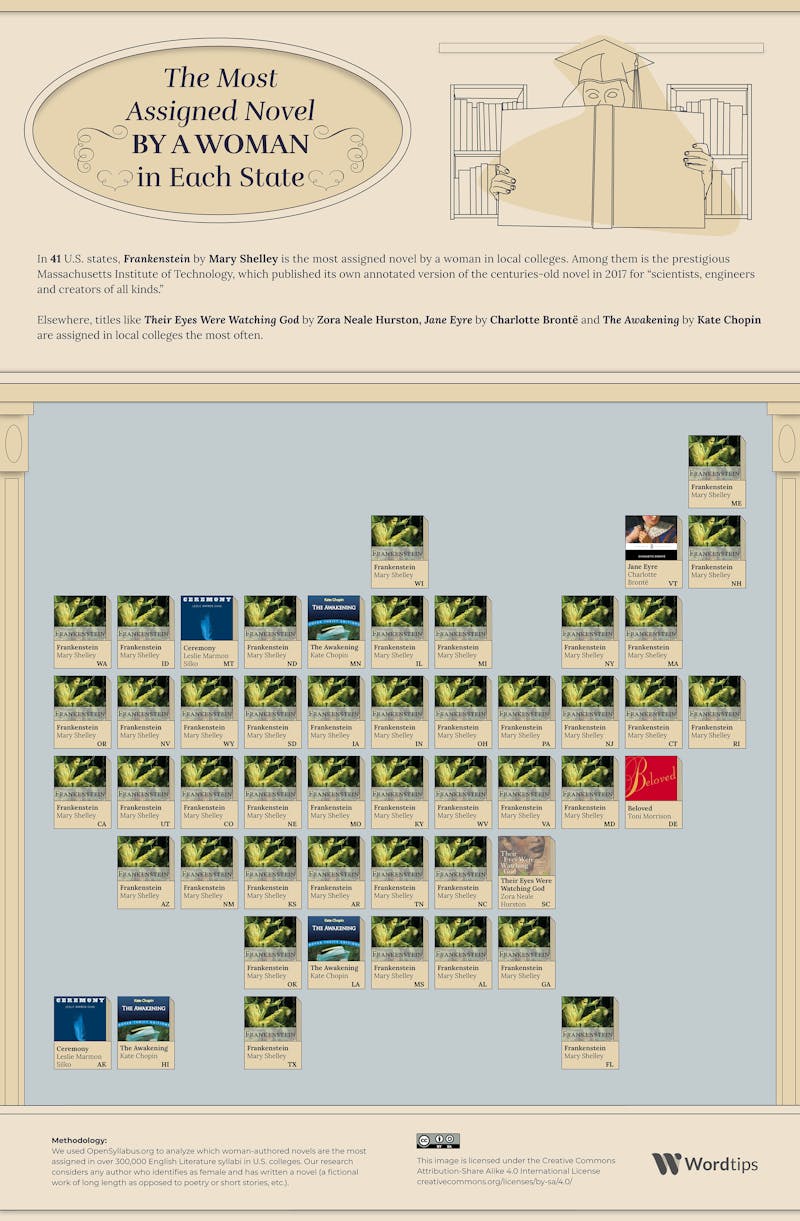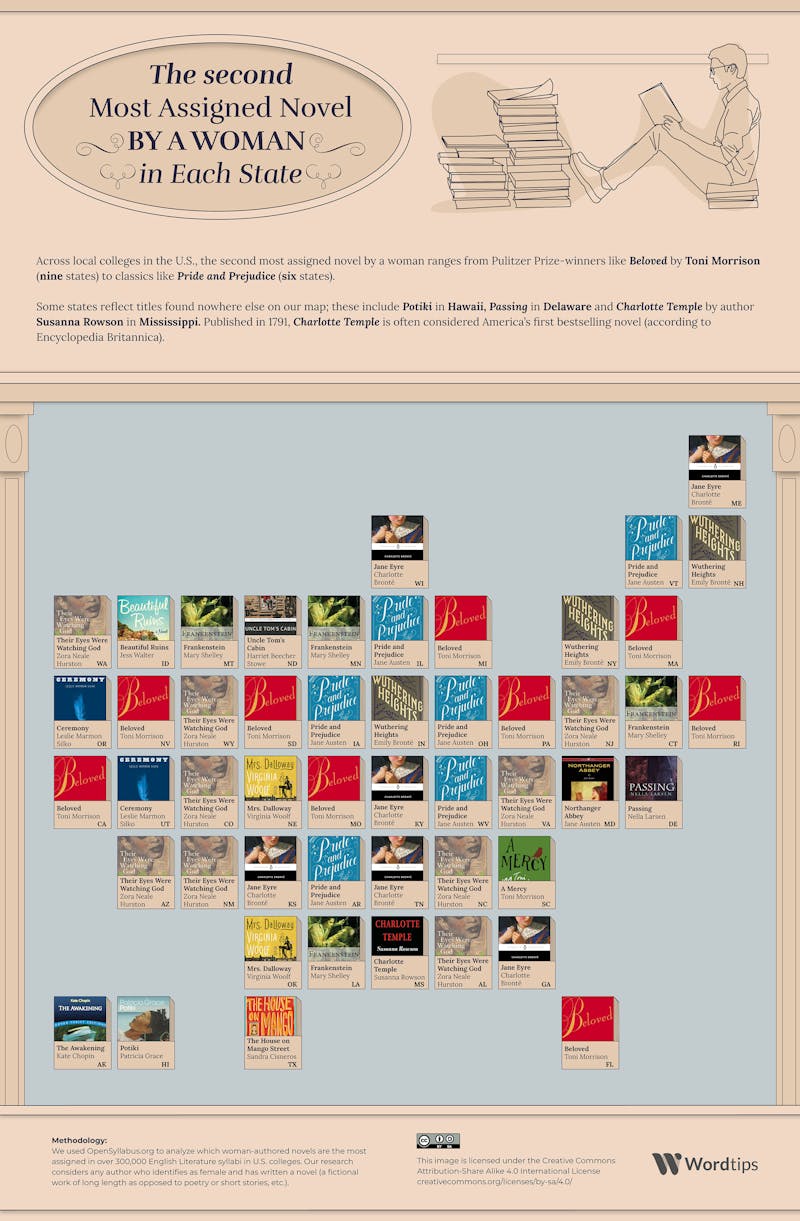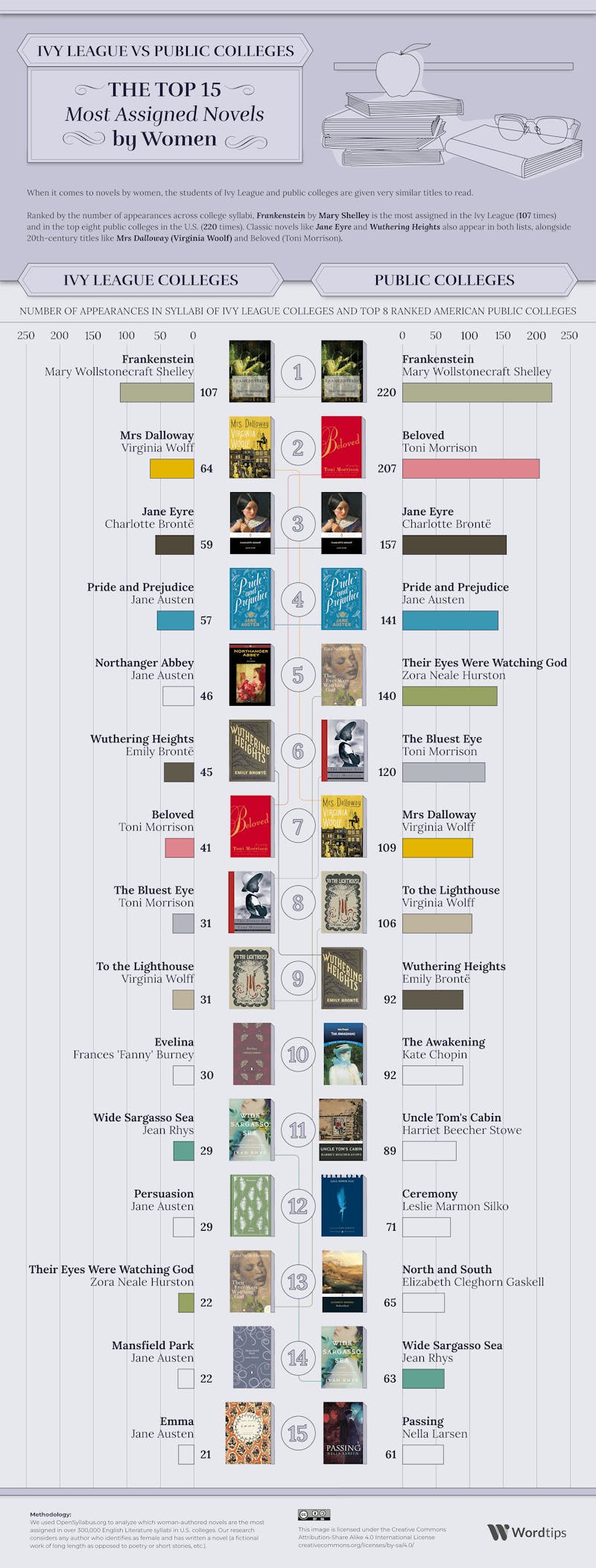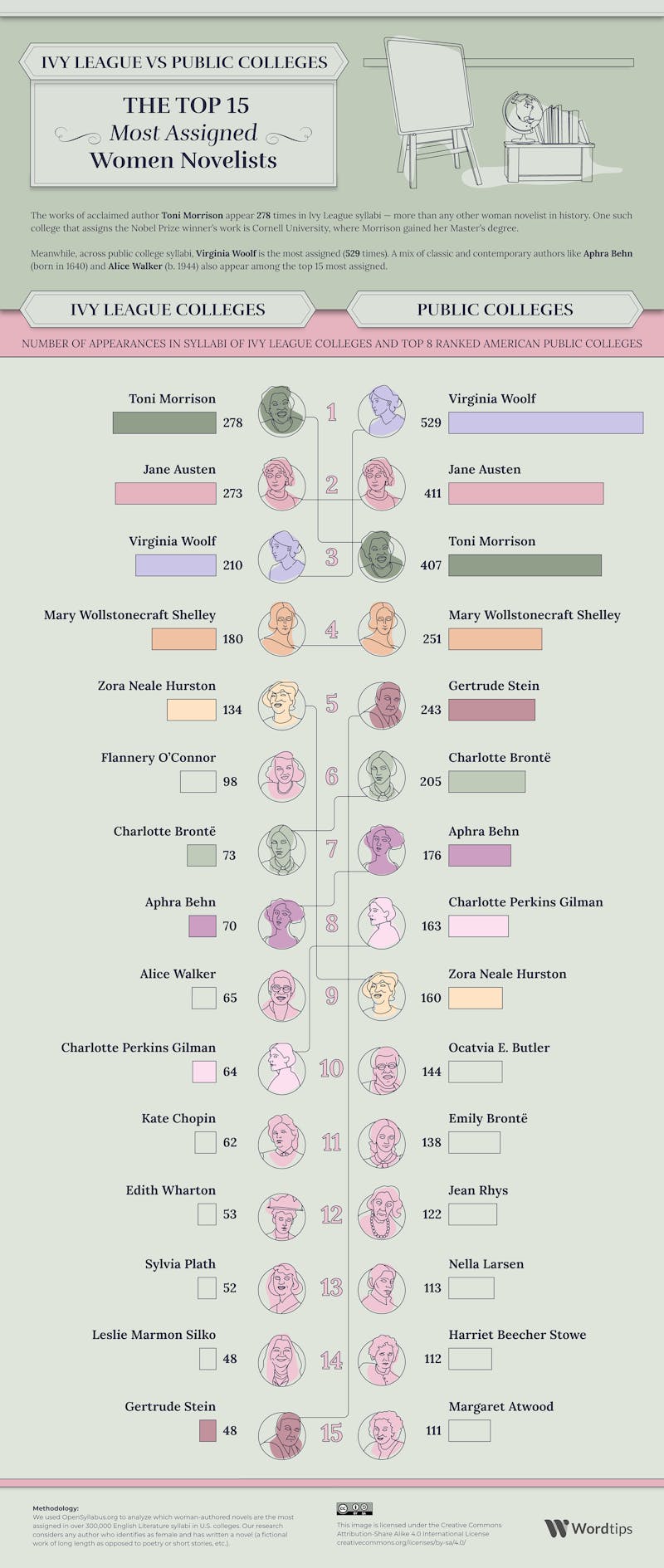The Most Assigned Women Authors and Novels in American College Classes
Last update: 11/28/2025

Just one out of three books on U.S. college reading lists were written by women.
It’s a shocking state of affairs in the third decade of the twenty-first century: an age in which women are still tempted to write under a pen name to beat the gender bias — understandably, since men are significantly less likely to read a book by a woman than women are to read a book by a man.
“People don’t read them because we assume women write only about ‘women’s concerns,’ which are assumed to be private, domestic, and small,” says Allison Schachter, an associate professor in cultural studies at Vanderbilt. “But questions about private, domestic life have been at the core of all of the major political transformations of the modern era.”
To compound the issue, readers may be more likely to think of a book in terms of its domesticity and “smallness” in the first place if they know a woman wrote them. As Irish novelist Anne Enright colorfully illustrates: “If a man writes ‘The cat sat on the mat’ we admire the economy of his prose; if a woman does, we find it banal… her concerns are clearly domestic…” For better or worse, this perspective suggests that a boost in the required reading of women writers is not the solution: rather, the issue requires addressing at a cultural level.
“Certainly, no one is beating a drum here to require literary quotas,” says Manini Samarth, senior lecturer in English and women's studies at Penn State. “The problems lie deeper, arising from limiting definitions of women as nurturing, emotional, non-intellectual entities who simply don't write as well as men. And that, of course, leads to a related question: Who determines literary value, and is there a gendered component to such valuation?”
We know that schools teach men’s books more than those by women. But WordTips wondered what the culture of women’s literature on U.S. syllabi looked like. So we found out which women authors and their novels are assigned the most across the country and from state to state.
What We Did
WordTips analyzed which woman-authored novels are the most assigned in over 300,000 English Literature syllabi in U.S. colleges using OpenSyllabus.org.
Key Findings
- Frankenstein by Mary Shelley is the most assigned novel by a woman:
It features in 4,789 syllabi, more than any other novel by a woman.
It is the most assigned novel by a woman in 41 states.
It is read the most in Ivy Schools (107 syllabi) and top public colleges (220 syllabi among the country’s top eight colleges). - Their Eyes Were Watching God by Zora Neale Hurston is the second most assigned novel by a woman, appearing in 2,053 syllabi.
- Virginia Woolf is the most read woman novelist, with her works appearing 8,054 times across U.S. college syllabi.
- Toni Morrison is the most read woman novelist at Ivy League schools, with her works appearing 278 times across their syllabi.
Virginia Woolf is the Most Assigned Woman Author in the U.S.
Frankenstein, by Mary Shelley, is the most assigned novel by a woman, appearing on 4,789 U.S. college syllabi. As the editors of a critically annotated version that MIT created for scientists and ‘inventors’ put it, “engaging with Frankenstein allows a broad public and especially future scientists and engineers to consider the history of our scientific progress together with our expanding abilities in the future and to reflect on evolving understandings of the responsibilities such abilities entail.” (Incidentally, a 2016 survey by Time that included non-fiction women writers found that Shelley was the sixth-most assigned writer, and her mother, Mary Wollstonecraft, author of A Vindication of the Rights of Woman (1792), was number nine.)
Zora Neale Hurston’s Their Eyes Were Watching God is the second most assigned novel in the U.S. This is an especially significant achievement for the author, since as early as 1970, ten years after her death, Hurston’s novels had fallen out of print with none having sold more than 5,000 copies. But it was not a case of waiting for her moment to come: activists and educators had to campaign to get the writing they deemed so essential into the limelight.
“Her work had a sense of black people as complete, complex, undiminished human beings and that was crucial to me as a writer,” says author Alice Walker, whose 1973 article on the then-forgotten writer was instrumental in establishing her canonical status.
Virginia Woolf and Toni Morrison are neck and neck for most assigned novelist, when considered across writers’ full bodies of work. Woolf’s oeuvre is ripe for the classroom due to its overarching themes, ground-breaking formal techniques and social politics. Her wealth of non-fiction essays helps contextualize all the above, leading to a broad variety of takes on the subject. Ironically, there’s even a syllabus that explores how Woolf’s writing was “affected by her embittered sense of being peripheral to academia.”
Frankenstein is the Most Assigned Novel Written By a Woman in 41 States
Perhaps the U.S. is something of a Frankenstein country, pieced together from disparate sources and jolted into life by its turbulent early history. On the other hand, Mary Shelley’s Frankenstein is something of a Frankenstein book, combining bits of science, philosophy and gothic horror — with Shelley arguably inventing science fiction as we know it in the process — which makes it a cross-discipline tome that appears on literature, theology and women’s studies programs among others. In short, it’s the most assigned novel by a woman in 41 states, making the picture below somewhat less of a patchwork than the monster himself (also named Frankenstein).
After Frankenstein, The Awakening by Kate Chopin is the most assigned novel in the most states: Hawaii, Louisiana and Minnesota. The awakening concerns a woman’s journey of self-discovery on holiday away from her husband on Grand Isle, Louisiana. Its portrayal of the awakening of sensuality was, to many readers and critics in 1899, all a bit much — “too strong a drink for moral babes” — and the book was censored, if not banned outright, at the time. Chopin’s work is studied and celebrated for its role in re-positioning ‘women’s writing’ and for the path it trod for fellow women from the south — but, like Zora Neale Hurston, much of this was only possible when readers and academics rescued Chopin’s book from obscurity many years on.
Since Frankenstein has left his footprints all over 41 states, it seemed fair to also celebrate the second most assigned novel by a woman from each state. There are two books that are each most read in nine states. Their Eyes Were Watching God, of which Alice Walker proclaimed: “There is no book more important to me than this one.” Walker sums up the power and importance of the book in a celebratory poem to the novel’s protagonist:
i love the way Janie Crawford
left her husbands the one who wanted
to change her into a mule
and the other who tried to interest her
in being a queen
a woman unless she submits is neither a mule
nor a queen
though like a mule she may suffer
and like a queen pace
the floor.
Toni Morrison’s Beloved (1987) is the other nine-stater. Assigning Beloved solves two problems at once for teachers: “finding texts about American history that interest teenagers, and expanding the course’s curriculum to include more women.”
Ivy League vs. Public Colleges: A Tale of Multiple Austens
How do Ivy League reading lists measure up to those of the top eight public colleges? For one thing, they’re less diverse: the most common 15 novels in the Ivy League were written by nine women, while 13 different novelists are responsible for the top books in public colleges. There is significantly more Jane Austen in the Ivy League, where Northanger Abbey, Persuasion, Mansfield Park, Emma and Pride and Prejudice are regular reads — only the latter features in the public college top 15.
However, when we break it down by syllabus (below), Jane Austen appears on the second highest number of courses at both sets of universities — but 138 more syllabi in public colleges than the Ivy League. The New York Times has explored a number of ways of approaching an Austen novel or her whole oeuvre in the classroom. However, neither our data nor the Times can reveal which type of school has the most Janeiacs (Jane Austen experts) vs. Janeites (who “attend Austen conventions, dress in period costumes, learn Regency-era dances, or travel to the spots where Austen lived and worked.”).
Finally, a fellow science-fiction author joins Mary Shelley in this last appraisal. Octavia E. Butler is the tenth-most taught woman writer in the top eight public colleges in the U.S. But, that’s not to say that Butler is not taught in the Ivy League; one Brown professor for whom Butler was the foundational point of a seminar on Black speculative fiction says: “for me, this class has been a gift — a weekly reminder of the power of imagination to draw up futures that center Black life, and to disrupt what seems possible or pre-determined.”
Opening the Door to Wonder
It’s possible that limiting high school pupils to a palette of male writers and dusty classics bounds their taste early on and reduces the chance that they’ll question a badly weighted reading list in college.
Not unconnected is the fact that school reading lists perpetuate — or potentially re-populate — the literary canon. When a generation or more reads the same book at college, it gains a kind of blessed aura and becomes a de facto classic if it wasn’t already considered one.
It’s not that there’s no value or less value in commonly assigned works by men or by women who got a pass for writing centuries ago. The most commonly assigned novels “speak of empathy and humanity, and challenging blunt authority imposed from on high,” writes English teacher and author Jeffrey Boakye. “But they also assume default narratives that come from ideologies so wide that we can’t easily see the edges of them, default masculinity and default whiteness being two of the biggest. We can’t ignore the fact that these books were written at points in history when social narratives were mainly limited to the perspectives of straight white men.”
A broader reading list opens up not just perspectives but whole universes for readers. As Mississippi-born writer Eudora Welty once said of Virginia Woolf’s To the Lighthouse: “Blessed with luck and innocence, I fell upon the novel that once and forever opened the door of imaginative fiction for me, and read it cold, in all its wonder and magnitude.”
METHODOLOGY & SOURCES
We used the website Open Syllabus to analyze the women novelists and novels authored by women assigned in over 300,000 English Literature syllabi in U.S. colleges. Open Syllabus tracks the books listed in over seven million syllabi in colleges and universities across the world.
For the purpose of our research, any author who identifies as female and has written novels (a work of fiction of a long length) was considered. Poems, short stories and anthologies were not considered.
Beyond the national and state-level comparisons, we also explored the differences between the women novelists and woman-authored novels assigned at Ivy League colleges and the top eight ranked public schools, as defined by U.S. News. Please note that the number of Ivy League and public school syllabi analyzed are not identical, so appearance differences cannot be compared between the two types of schools, only compared within each ranking to identify the most popular novels/novelists.
Disclaimer: we use the terms woman and/or women to describe authors whose sex assigned at birth was female, whether they currently identify as female, male or non-binary.





